The Best Medinas In Morocco
Exploring the souks and shops of Morocco's old towns
September 2023 earthquake
Note the Atlas/Marrakech region of Morocco experienced a major earthquake on 8 September 2023. There is widespread disruption, and recovery efforts are underway. All travel to the region is highly discouraged. If you'd like to support the people affected you may donate to the Intrepid Foundation appeal here.
Morocco is a land that conjures images of the vast Sahara Desert, colourful markets and trendy riads. And with tourism a priority of the government, (the country aims to be one of the top 20 tourist destinations in the world by 2020), this North African kingdom feels safe, secure and on the move. No trip to Morocco is complete without exploring at least one of its many medinas.
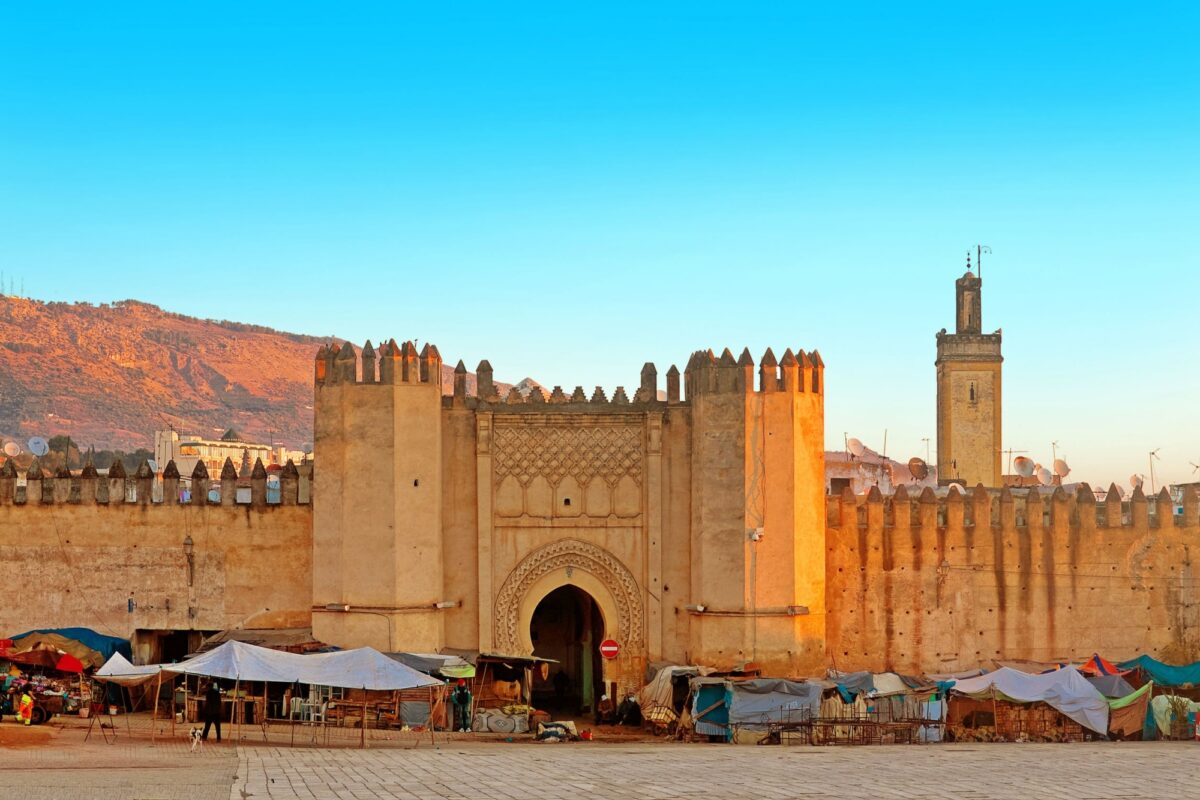
Entrance to Fes Medina
What is a medina in Morocco?
In Morocco, a medina simply refers to a city’s old town or historical centre. Seven of Morocco’s medinas are included on the UNESCO World Heritage Site list and they are fascinating places to visit.
King Mohamed VI recently inaugurated Bayt Dakira, a restored building highlighting Jewish heritage, in the Essaouira medina. The magic of Marrakech never ceases to enchant, while wandering through the narrow alleyways of Fez feels like a journey back in time. It’s understandable that a stay in a riad within the walls of these centuries-old cities is on the must-do list of most travellers visiting Morocco.
It is here in the old cities that travellers find themselves in the heart of the action – cavernous carpet shops where hours are whiled away sipping mint tea in an attempt to find the perfect rug. Spice shops lined with perfumes, hand-written signs describing potions for the adventurous, and perfectly displayed spices. And, of course, workshops passed down from generation to generation where artisans still produce handmade crafts.
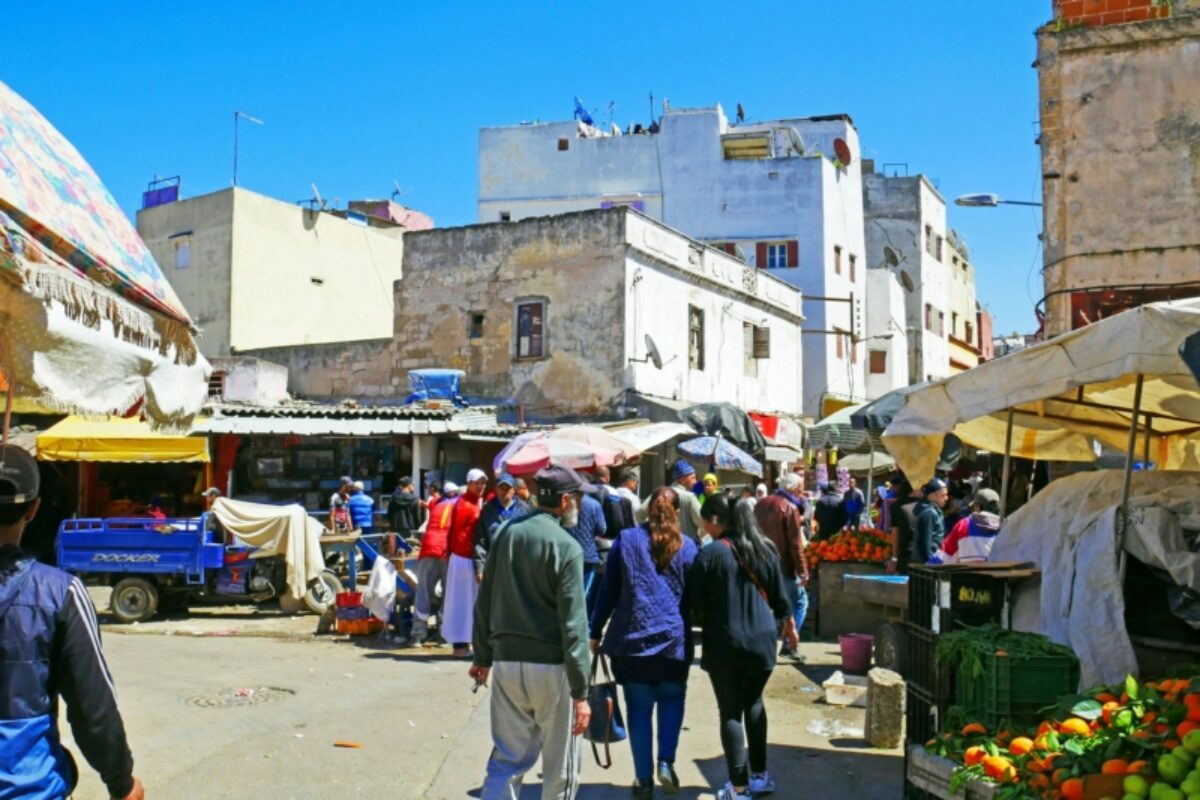
Crowd of people, Casablanca medina
What to see in a medina in Morocco
Historical monuments including koranic schools, palaces and mosques attest to the cities’ long history. While it’s easy to get caught up in sightseeing, Morocco’s medinas themselves are often a sight as well. Grab a spot in a cafe and watch the world go by. Step into an unassuming restaurant flooded with locals and order the preferred dish. Sip tea with an artisan in his workshop to learn more about his craft or trade – make a pair of babouche slippers, learn to hand cut zellig tiles that line the walls of the finest palaces, or try your hand at pottery. Wander down the little alleyways to seek out smaller and lesser-known museums and you may find yourself rewarded – typically in the form of meeting a friendly local – who will share his or her passion for the subject matter.
In Morocco’s medinas, mosques and zaouia (religious schools) shrines are closed to non-Muslims. Expect a slower pace on Fridays, the holy day, until at least late afternoon when business tends to resume throughout Morocco’s medinas. To experience the Friday ambience, listen to the midday prayers while sitting on a rooftop terrace. Keep in mind the medinas are the more traditional neighbourhoods within each city. As such, alcohol can be difficult to find in restaurants and bottle shops are non-existent.
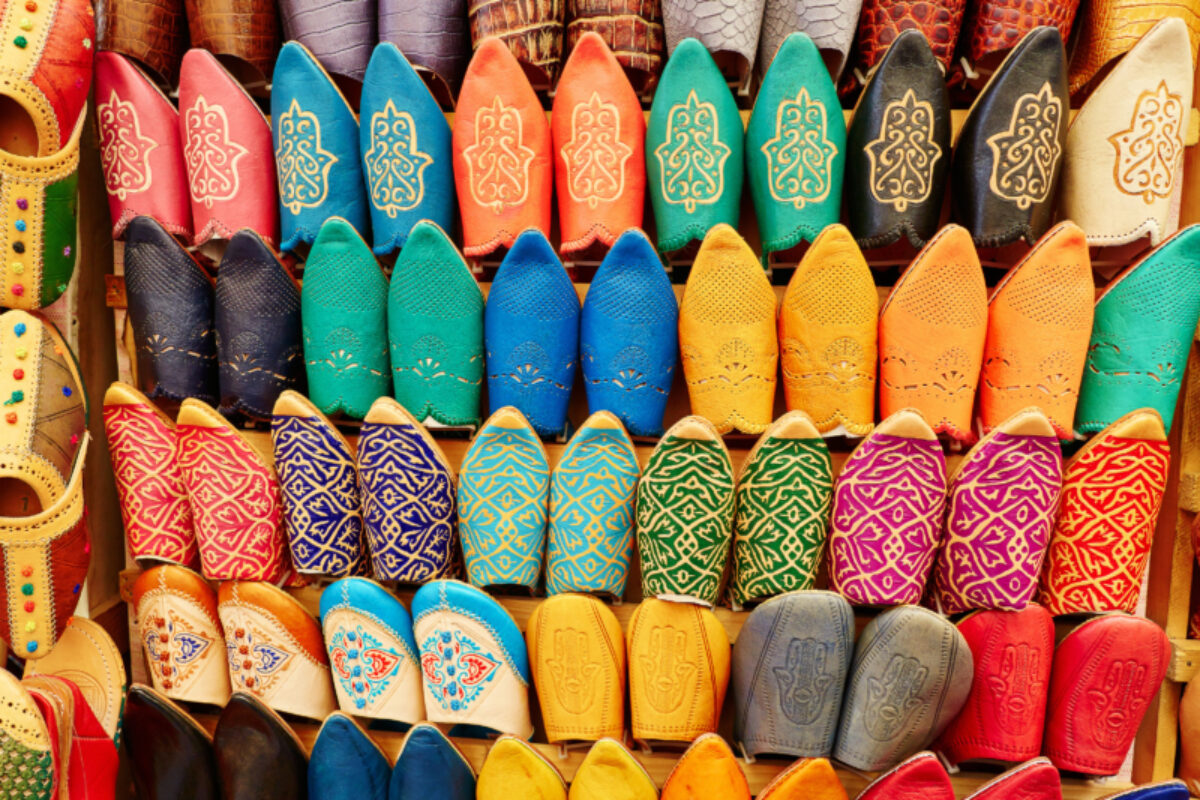
Babouche slippers for sale, Morocco
Negotiating is part of daily life in Morocco souks and international shoppers are no exception. Be prepared to negotiate from about 40% of the starting price until finally agreeing upon a price that’s both fair for the buyer and the seller. Remember, it’s ok to walk away from a negotiation and shoppers shouldn’t feel pressured to buy.
The medinas of Fez and Marrakech are renowned for their historic riads – Marrakech on the trendy, contemporary side and Fez with its high ceilings, decades-old intricate zellig and stucco work. When deciding on a riad, particularly in the medina of Marrakech, be sure to check which restaurants, historical monuments and other riads are nearby. Many riads advertise being ten minutes from the famous Jemaa el Fna square, which is technically true, but only if you’re a local and know shortcuts.
While Moroccans are incredibly friendly and hospitable people, be aware that faux guides do roam. In Marrakesh, men on bicycles claiming to work at nearby hotels are common. These false guides often lead visitors to local spice or carpet shops, where they feel an obligation to buy. It’s best to avoid this type of assistance and instead seek the services of a state-approved guide who can provide insight into the historical sites as well.
Medina of Marrakesh
Palaces, riads and the magic of the Jemaa el Fnaa
Under the French Protectorate (1912-1956), a new city of Gueliz was developed near the Marrakesh medina to lure travellers seeking an exotic destination. Today, more than 100 years on, Marrakesh continues to attract travellers to both the new city and the medina.
In fact, Marrakesh’s old city is gentrifying to the point of becoming unrecognisable to anyone who has travelled here in the last ten years. Riads with modern conveniences and contemporary designs have become boutique guesthouses, while rooftop terrace restaurants provide views from above and a magical setting as the call to prayer sounds throughout the medina. More and more trendy designers are opening air-conditioned shops, replacing old shop fronts which traditionally displayed their wares on the street.
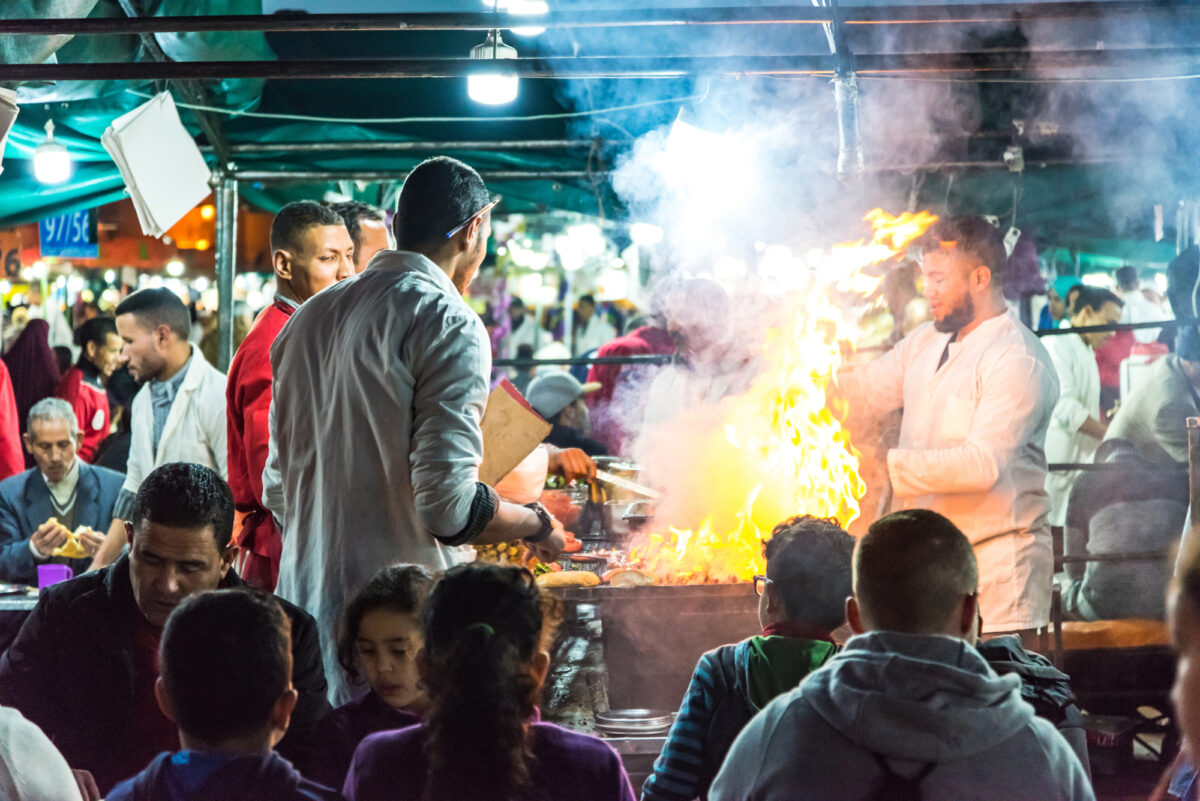
Streetfood in the Jemaa el Fnaa square
Despite the changes, Marrakesh’s medina remains steeped in history having passed under both Almoravid and Saadien rule – and at one point becoming the capital of the country.
Marrakesh was founded in the 11th century with the Koutoubia Mosque, the city’s iconic landmark, rising over the city. Visible from all directions, local building regulations restrict buildings to five storeys to avoid blocking views of the mosque.
From here, the famous Jemaa el Fna square changes throughout the day. Snake charmers entertain travellers from morning to sunset, while storytellers tell enchanting tales as afternoon turns to evening. After sunset prayers are called, musicians perform tribal music from across the country, creating a lively buzz as smoke from the nearby food market grills rises above. If you’re planning to visit the famous square and snap a few photos, remember that the entertainers live from their tips. Ten dirhams is a sufficient tip for the halkas (storytelling and musical circles) while 20 dirhams should satisfy the snake charmers. Just be sure to have small bills.
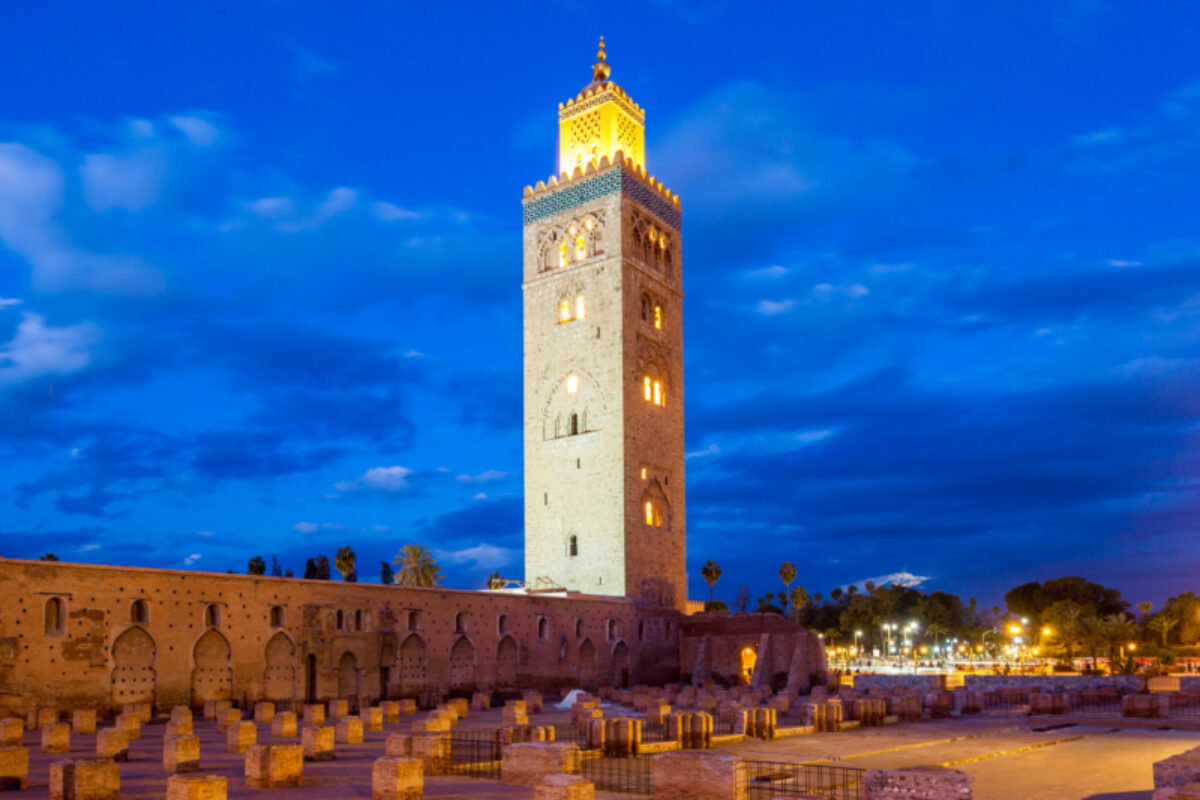
Koutoubia Mosque at night, Marrakesh
Palaces both centuries old – see the Badii Palace which dates back to the 16th century but today lies in ruins – to more recent constructions such as the 19th century Bahia Palace are worth seeking out. More recently, the 20th century Dar el Bacha Palace (once home to politician Pacha el Glaoui, who ruled Marrakesh during the French Protectorate era) is open to the public after being reclaimed by the state following independence in 1955. Look for its beautiful zellig, intricate plasterwork and art exhibitions around the main courtyard. The palace remains an official residence with a police presence at the building’s exterior.
Medina of Fes
Morocco's most ancient old town
Once a small Amazigh village, the city of Fes grew centuries ago as Muslim residents of Andalusia fled persecution, finding refuge in this city divided by the River Fes. Established in the eighth century, Fes is home to the world’s oldest university (University of Al-Qarawiyyin, founded in 859 and still operating today) and is considered the cultural and spiritual capital of Morocco. While the much-anticipated Al-Qarawiyyin Library within the university complex opened very briefly following a restoration led by local architect Aziza Chaouni, it is now open only on request. Other must-see historical sites in Fes include Medersa Bou Inania, El Attarine Medersa, the Glaoui Palace and Batha Museum.
However, it is the local artisans that make Fes truly unique. Master artisans create beautiful pottery and turn hand-cut tiles into impressive zellig patterns (a craft that takes several years to master) based on geometric designs for tabletops, fountains and wall mounts. In Fes medina’s metalsmith district, it’s common to find artisans hammering brass kitchen materials and carving the finest details in copper trays.
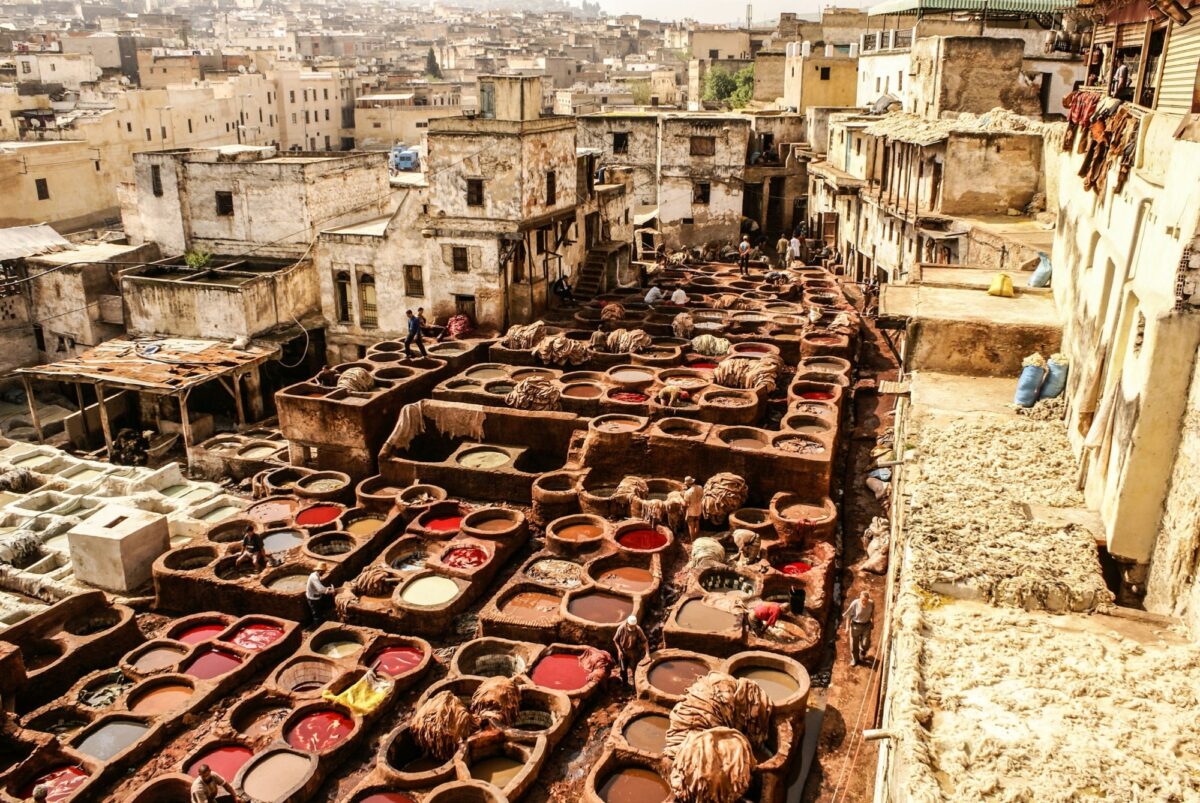
Tannery in Fes
You’ll notice the medina’s three leather tanneries by the strong smell coming from the dye pits – a pungent mix of rotting cow flesh for leather, bird poo and cow urine. Head to the thousand year old Chouara tannery to see men waded through these pits to tan the hides that become colourful bags, belts, leather jackets and boots on display in shops throughout the town. Fans of the famous babouche slipper will find a great selection in Fes.
Go beyond the architecture and the artisans to explore another important element of Moroccan culture in the medina of Fes – food. Head for Bab Boujloud at the western entrance to the medina, where small hole-in-the-wall cafes sells bissara (bean) soup in the morning with lashings of olive oil and sprinkling of cumin and paprika to be mopped up with a fresh loaf of khobz bread. Mountains of gooey pastries stuffed with almonds and orange-blossom water await those with a sweet tooth. And fresh from the griddles, grab a pancake stuffed with harissa, onions and olives and slathered in Laughing Cow cheese for a savoury snack.
Fes is a more conservative city than more modern Marrakesh, so alcohol is harder to find in restaurants and guest houses. Sip mint tea instead.
Medina of Casablanca
An old town with sea views
Given the size and population of Casablanca today, it’s hard to imagine that prior to 1912 this little medina, formerly known as Anfa, was all that existed. It was only after the French arrived that development of the city centre and its port began, and the residents of Anfa were relocated to the newly created medina of Habous.
But let’s start with the old medina, one where few travellers wander. Today, Casablanca’s medina retains a vibe that differs from other old towns in Morocco.
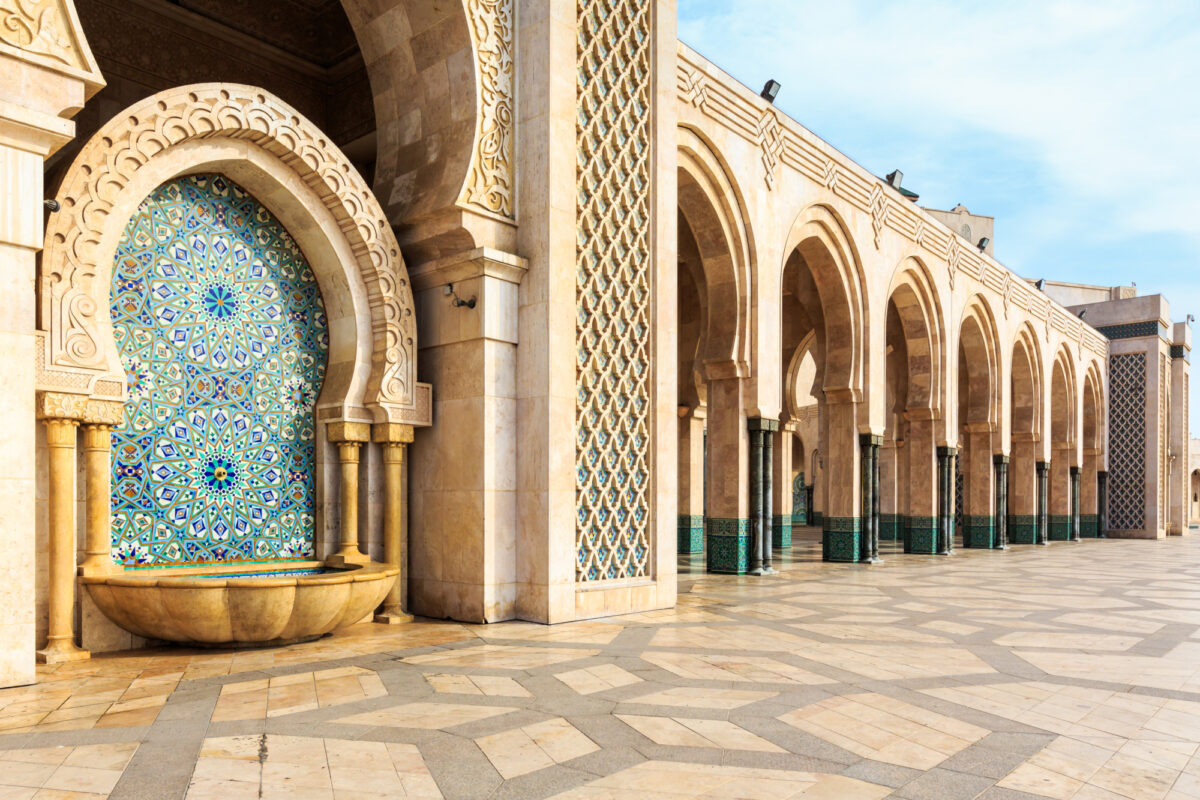
Hassan II Mosque, Casablanca
Entering via Bab el-Marsa, Place Ahmed Bidaoui is the perfect spot for coffee in the sunshine while watching the world go by. It was through this gate that General Lyautey entered Casablanca in 1912 when the country came under French protectorate. For a throwback, stay at Hotel Centrale with views overlooking the busy port which still bustles long after the Protectorate ended. Further along, wander up to Dar el-Ittihad with its sombre facade and pleasant gardens where General Lyautey lived. This is a place that feels a little different to the rest of Morocco, with more in common with Havana in Cuba than Fes.
Found mere steps from each other, the Ettedgui synagogue, the Spanish Eglise Buenaventura and the Jemaa ould el-Hamra mosque (dating back to the 1700s) attest to Casablanca’s once diverse population. Large merchant homes line the streets alongside shrines and local markets. Street food stalls dot the small alleyways. Find one popular with locals and grab a seat and sample the local specialities, often costing mere dirhams.
Today, beyond the walls of this small medina, art deco homes built during the Protectorate era line the downtown core, while post-colonial modernist architecture is found just streets away.

Medina of Casablanca
Over in the Habous neighbourhood (or the new medina as it’s sometimes referred to) the Makhama du Pacha is an architectural masterpiece. Built as municipal administrative offices, the buildings’ rich decoration includes traditional Islamic architecture with arches and walls covered in intricately carved stucco, hand-carved wooden doors painted turquoise in a courtyard style, and an impressive Andalusian-style patio where more offices are located.
Commerce played an important role in Habous and today the arcade-like streets are the go-to spot for traditional artisanal crafts in Casablanca. Stop in at Patisserie Bennis for some chebakiya (deep-fried pastries coated in rosewater syrup) and other sticky sweet treats before heading to a café in Place Moulay Youssef where the nearby mosque resembles the Koutoubia Mosque in Marrakech.
Alternatively, grab a seat and a mint tea at Cafe Imperial for views of the Makhama du Pacha. Stop by the olive souk to sample different flavours – purple, green and black – and shop for harissa and preserved lemons.
On Thursday evenings, Dar Al Ala, Casablanca’s museum dedicated to Arab-Andalusian musical history, hosts live Andalusian musical concerts. The Andalusian-style Dar al Kitab (meaning house of the books) houses a small bookshop and art gallery for a dose of culture in Habous.
Medina of Essaouira
Argan oil, blue doors and a revived Jewish quarter
Famous for its thuya (cedar) wood, argan oil, Jewish heritage (Essaouira’s medina was once home to more than 30 synagogues) and Gnaoua music, the Essaouira medina is a hive of activity, with private lives tucked away behind sturdy blue doors. Once known as the Port of Timbuktu (due to the number of African goods that ended up here), the city has a rich history of trade and was included on the UNESCO World Heritage list as an example of an 18th-century fortified old town. A wander down to the bustling port just off the popular Place Moulay Hassan provides a glimpse into the life of a fisherman. Here, you can see small boats returning with their catch, which is often sold locally.
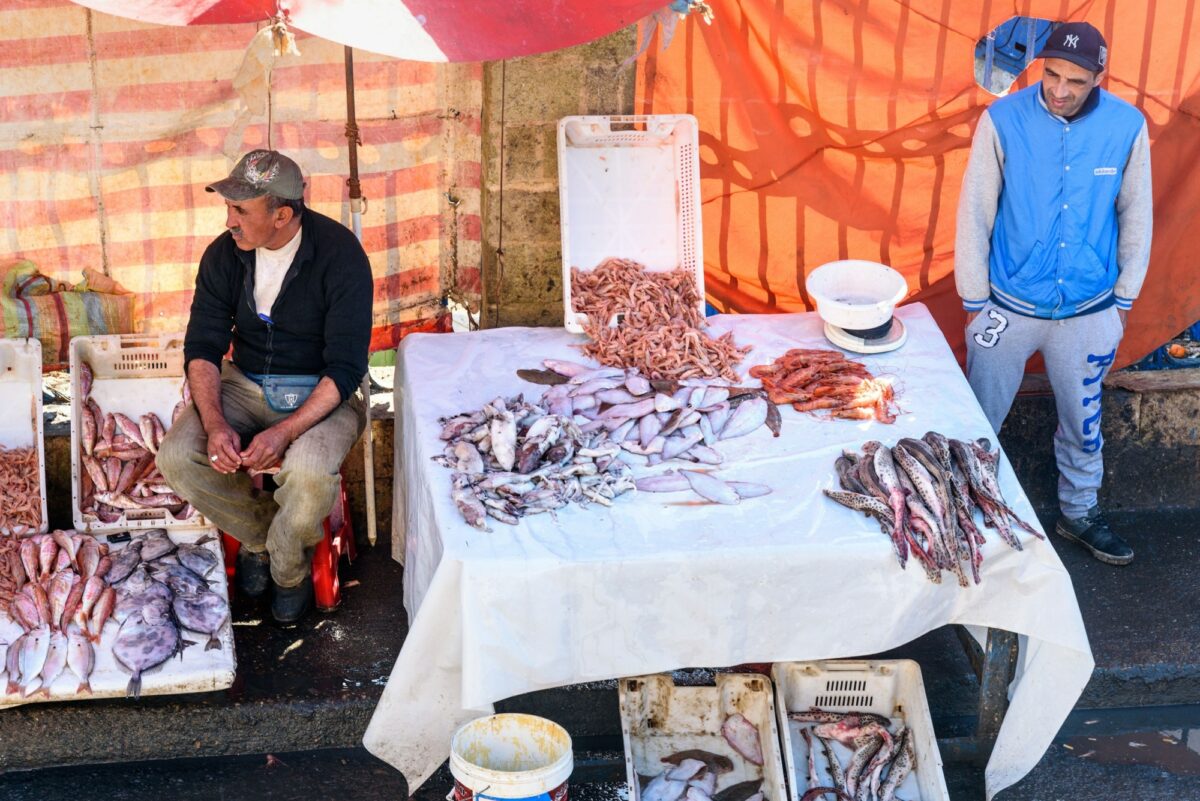
Fishermen, Essaouira
Essaouira’s medina is full of cultural sites. Wander through the medina from Place Moulay Hassan and turn right down Derb Messaouda where the facade of the Portuguese church remains next to the former Portugese embassy, both buildings abandoned.
Essaouira’s Skala is a popular tourist destination due to being used in Game of Thrones. Its bastions provide breathtaking views over the ocean, particularly at sunset when the waves crash against the rocky coastline. Over in the mellah (Jewish) district, the Slat Kahal and Haim Pinto synagogues remain open to visitors. In January 2020, Morocco’s King Mohamed VI officially opened the Bayt Dakira museum, within the former residence of the late Essaouira merchant Simon Attia. Also home to the Attia synagogue, the museum pays tribute to Essaouira’s Jewish community and its contribution to the medina over the centuries. A display of traditional dress and religious objects, Andalusian music (the city also hosts the Andalusian music festival every October) and profiles of prominent community members are on display.
Throughout Essaouira medina, you’ll hear the rhythmic sounds of Gnaoua music playing. The spiritual music, which combines chanting, castanets and dancers, recently made its way onto the UNESCO World Heritage Site for intangible culture. The city plays host to the annual Gnaoua and World Music Festival every June.
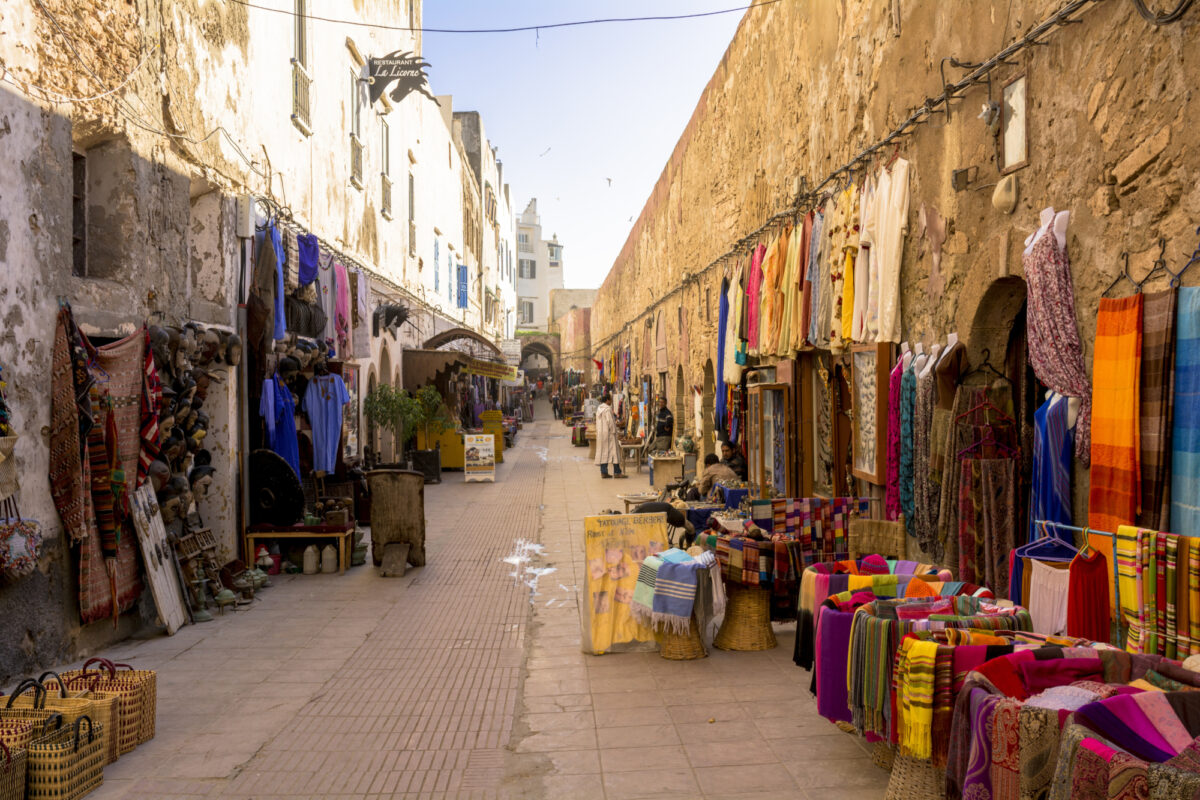
Essaouira medina
Essaouira is much slower-paced than nearby Marrakesh, with many travellers heading here as respite from Morocco’s hectic cultural capital. Head towards Rue Chbanate to escape the crowds and meet woodworkers using locally-sourced thuya wood to create intricate bowls, plates and bangles in tiny family-owned workshops. Keep in mind that when buying directly from the artist, you’re cutting out the middle man so prices are often much lower, meaning less haggling – if any – is necessary.
One final word of warning – Essaouira is known for the stiff winds that blow in from the Atlantic year-round. This makes it an excellent place to try windsurfing and kitesurfing, but less friendly for those looking to relax on the beach. Layers are recommended, even in the height of summer.




